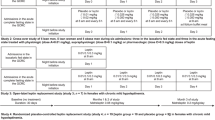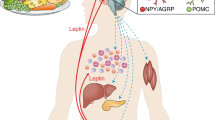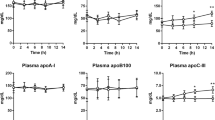Abstract
OBJECTIVE: The pharmacokinetics and tissue distribution of leptin in rats was investigated.
DESIGN: A catheter was inserted in the right jugular vein of rats on the day prior to experiment. The next day, blood was sampled and then a tracer dose of radioiodinated hormone was administered via the catheter. Thereafter, small (200 μl) samples of blood were taken at regular intervals. Two experiments were conducted over different sampling times. TCA precipitated radioactivity was counted in samples of plasma and tissues. Pharmacokinetic parameters were calculated after fitting a bi-exponential equation describing a two-pool model of plasma leptin distribution. Selected time-point plasma samples were fractioned using size exclusion chromatography and the leptin distribution determined.
RESULTS: The two pool model described the pharmacokinetics of leptin in two forms: an initial fast decaying pool (t½=3.4 min) and a slower decaying pool (t½=71 min) with an overall clearance rate of 6.16 ml/min/kg. Size exclusion chromatography showed a persistent peak (all time-points tested) of 125I-leptin corresponding to the plasma albumin peak. The size of the free 125I-leptin peak became diminished or absent in later time-point plasma samples. Tissue distribution of leptin at 60 min and 180 min time-points showed that the small intestine contained the highest concentration of leptin, almost four times the level found in kidneys, liver, stomach and lungs. 125I-leptin was least abundant in skin, muscle, heart, caecum and brain.
CONCLUSION: The pharmacokinetics of leptin are affected by three important factors: 1) its ability to bind to a plasma carrier molecule which increases its half-life; 2) its association with abundant peripheral tissue binding sites which creates an additional pool of leptin and 3) the rate of synthesis of leptin which may be less important than originally believed as the prolonged half-life and the additional pool of tissue binding sites are important factors in determining its plasma concentration.
This is a preview of subscription content, access via your institution
Access options
Subscribe to this journal
Receive 12 print issues and online access
$259.00 per year
only $21.58 per issue
Buy this article
- Purchase on Springer Link
- Instant access to full article PDF
Prices may be subject to local taxes which are calculated during checkout
Similar content being viewed by others
Author information
Authors and Affiliations
Corresponding author
Rights and permissions
About this article
Cite this article
Hill, R., Margetic, S., Pegg, G. et al. Leptin: its pharmacokinetics and tissue distribution. Int J Obes 22, 765–770 (1998). https://doi.org/10.1038/sj.ijo.0800656
Received:
Revised:
Accepted:
Published:
Issue Date:
DOI: https://doi.org/10.1038/sj.ijo.0800656



